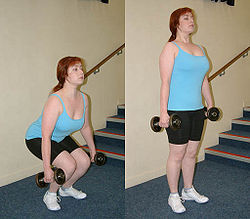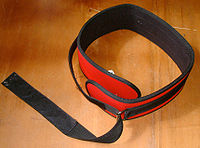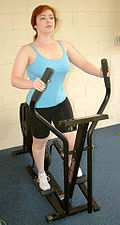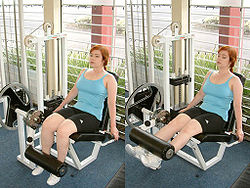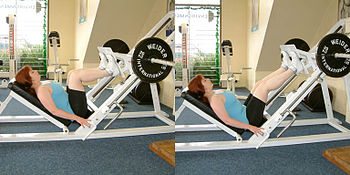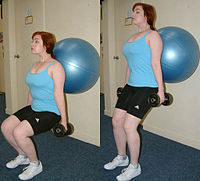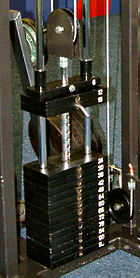
Weight training
Background Information
SOS Children produced this website for schools as well as this video website about Africa. Child sponsorship helps children one by one http://www.sponsor-a-child.org.uk/.
Weight training is a common type of strength training for developing the strength and size of skeletal muscles. It uses the force of gravity (in the form of weighted bars, dumbbells or weight stacks) to oppose the force generated by muscle through concentric or eccentric contraction. Weight training uses a variety of specialized equipment to target specific muscle groups and types of movement.
Weight training differs from bodybuilding, weightlifting, powerlifting and strongman, which are sports rather than forms of exercise. Weight training, however, is often part of the athlete's training regimen.
Weight training versus strength training
Strength training is an inclusive term for all types of exercise devoted toward increasing muscular strength and size (as opposed to muscular endurance, associated with aerobic exercise, or flexibility, associated with stretching exercise like yoga or pilates, though endurance and flexibility can improve as a byproduct of training). Weight training is one type of strength training and the most common, seen by all but specialists as synonymous with strength training. The difference between weight training and other types of strength training is how the opposition to muscular contraction is generated. Resistance training uses elastic or hydraulic forces to oppose muscular contraction, and isometric exercise uses structural or intramuscular forces (e.g. doorways or the body's own muscles).
History of weight training
Hippocrates explained the principle behind weight training when he wrote "that which is used develops, and that which is not used wastes away." Progressive resistance training dates back at least to Ancient Greece, when legend has it that wrestler Milo of Croton trained by carrying a newborn calf on his back every day until it was fully grown. Another Greek, the physician Galen, described strength training exercises using the halteres (an early form of dumbbell) in the 2nd century.
Another early device was the Indian club, which came from ancient Persia where it was called the "meels." It subsequently became popular during the 19th century, and has recently made a comeback in the form of the clubbell.
The dumbbell was joined by the barbell in the latter half of the 19th century. Early barbells had hollow globes that could be filled with sand or lead shot, but by the end of the century these were replaced by the plate-loading barbell commonly used today.
The 1960s saw the gradual introduction of exercise machines into the still-rare strength training gyms of the time. Weight training became increasingly popular in the 1980s, following the release of the bodybuilding movie Pumping Iron, and the subsequent popularity of Arnold Schwarzenegger. Since the late 1990s increasing numbers of women have taken up weight training, influenced by programs like Body for Life; currently nearly one in five U.S. women engages in weight training on a regular basis.
Basic principles
The basic principles of weight training are essentially identical to those of strength training, and involve a manipulation of the number of repetitions (reps), sets, tempo, exercise types and weight moved to cause desired increases in strength, endurance, size or shape. The specific combinations of reps, sets, exercises and weight depends upon the aims of the individual performing the exercise; sets with fewer reps can be performed with heavier weights.
In addition to the basic principles of strength training, a further consideration added by weight training is the equipment used. Types of equipment include barbells, dumbbells, pulleys and stacks in the form of weight machines or the body's own weight in the case of chin-ups and push-ups. Different types of weights will give different types of resistance, and often the same absolute weight can have different relative weights depending on the type of equipment used. For example, lifting 10 kilograms using a dumbbell requires significantly more force than moving 10 kilograms on a weight stack due to the use of pulleys.
Weight training also requires the use of ' good form', performing the movements with the appropriate muscle group, and not transferring the weight to different body parts in order to move greater weight (called ' cheating'). Failure to use good form during a training set can result in injury or a failure to meet training goals - since the desired muscle group is not challenged sufficiently, the threshold of overload is never reached and the muscle does not gain in strength.
Comparison to other types of strength training
The benefits of weight training overall are comparable to most other types of strength training - increased muscle, tendon and ligament strength, bone density, flexibility, tone, metabolic rate and postural support. There are benefits and limitations to weight training as compared to other types of strength training.
Weight training versus resistance training
Resistance training involves the application of elastic or hydraulic resistance to muscle contraction rather than gravity. Weight training provides the majority of the resistance at the beginning, initiation joint angle of the movement, when the muscle must overcome the inertia of the weight's mass. After this point the overall resistance alters depending on the angle of the joint. In comparison, hydraulic resistance provides a fixed amount of resistance throughout the range of motion, depending on the speed of the movement. Elastic resistance provides the greatest resistance at the end of the motion, when the elastic element is stretched to the greatest extent.
Weight training versus isometric training
Isometric exercise provides a fixed amount of resistance based on the force output of the muscle. This strengthens the muscle at the specific joint angle at which the isometric exercise occurs, with some lesser gains in strength also occurring at proximal joint angles. In comparison, weight training strengthens the muscle throughout the range of motion the joint is trained in, causing an increase in physical strength from the initiating through to terminating joint angle.
Weight training and bodybuilding
Although weight training is similar to bodybuilding, they have different objectives. Bodybuilders compete in bodybuilding competitions; they train to maximize their muscular size and develop extremely low levels of body fat. In contrast, most weight trainers train to improve their strength and anaerobic endurance while not giving special attention to reducing body fat below normal. Weight trainers tend to focus on compound exercises to build basic strength, whereas bodybuilders often use isolation exercises to visually separate their muscles and to improve muscular symmetry.
However, the bodybuilding community has been the source of many of weight training's principles, techniques, vocabulary, and customs. Weight training does allow tremendous flexibility in exercises and weights which can allow bodybuilders to target specific muscles and muscle groups, as well as attain specific goals.
Safety
Weight training can be one of the safest forms of exercise, especially when the movements are slow, controlled, and carefully defined. However, as with any form of exercise, improper execution can result in injury. When the exercise becomes difficult towards the end of a set, there is a temptation to cheat, i.e. to use poor form to recruit other muscle groups to assist the effort. This may shift the effort to weaker muscles that cannot handle the weight. For example, the squat and the deadlift are used to exercise the largest muscles in the body—the leg and buttock muscles—so they require substantial weight. Beginners are tempted to round their back while performing these exercises. This causes the weaker lower back muscles to support much of the weight, which can result in serious lower back injuries. To avoid such problems, weight training exercises must be performed correctly. Hence the saying: "train, don't strain".
An exercise should be halted if marked or sudden pain is felt, to prevent further injury. However, not all discomfort indicates injury. Weight training exercises are brief but very intense, and many people are unaccustomed to this level of effort. The expression " no pain, no gain" refers to working through the discomfort expected from such vigorous effort, rather than to willfully ignore extreme pain, which may indicate serious soft tissue injuries.
Discomfort can arise from other factors. Individuals who perform large numbers of repetitions, sets and exercises for each muscle group may experience a burning sensation in their muscles, which, contrary to popular belief, is not caused by lactic acid build-up. These individuals may also experience a swelling sensation in their muscles from increased blood flow (the "pump"). True muscle fatigue is experienced as a marked and uncontrollable loss of strength in a muscle, arising from the nervous system ( motor unit) rather than from the muscle fibers themselves. Extreme neural fatigue can be experienced as temporary muscle failure. Some weight training programs actively seek temporary muscle failure; evidence to support this type of training is mixed at best. Irrespective of their program, however, most athletes engaged in high-intensity weight training will experience muscle failure from time to time.
Beginners are advised to build up slowly to a weight training programme. Untrained individuals may have some muscles that are comparatively stronger than others. An injury can result if, in a particular exercise, the primary muscle is stronger than its stabilising muscles. Building up slowly allows muscles time to develop appropriate strengths relative to each other. This can also help to minimise delayed onset muscle soreness. A sudden start to an intense program can cause significant muscular soreness. Unexercised muscles contain cross-linkages that are torn during intense exercise.
Weight trainers commonly spend 5 to 20 minutes warming up their muscles with aerobic exercise before starting a workout. They also stretch muscles after they have been exercised. The exercises are performed at a steady pace, taking at least two to four seconds to lift and lower the weight, to avoid jerks that can damage muscles and joints.
Exercises where a barbell is held above the body, which can result in injury if the weight drops onto the lifter, are normally performed inside a squat cage or in the presence of one or more spotters, who can safely re-rack the barbell if the weight trainer is unable to do so.
Anyone beginning an intensive physical training programme is typically advised to consult a physician, because of possible undetected heart or other conditions for which such activity is contraindicated.
There have been mixed reviews regarding the use of weightlifting belts and other devices, such as lifting straps. Critics claim that they allow the lifter to use more weight than they should. In addition, the stabiliser muscles in the lower back and gripping muscles in the forearms receive less benefit from the exercises.
Wrist straps (also known as cow ties or lifting straps) are sometimes used to assist in gripping very heavy weights. The straps wrap around the wrist and tuck around the bar or weight being lifted, transferring some of the weight directly to the wrist instead of through the fingers. They are particularly useful for the deadlift. Some lifters avoid using wrist straps in order to develop their grip strength. Wrist straps can allow a lifter initially to use more weight than they might be able to handle safely for an entire set, and can place potentially harmful stress on the bones of the wrist.
Types of exercises
Isotonic and plyometric exercises
These terms combine the prefix "iso" (meaning "same") with "tonic" (strength) and "plio" (more) with "metric" (distance). In "isotonic" exercises the force applied to the muscle does not change (while the length of the muscle decreases or increases) while in "plyometric" exercises the length of the muscle stretches and contracts rapidly to increases the power output of a muscle.
Weight training is primarily an isotonic form of exercise, as the force produced by the muscle to push or pull weighted objects should not change (though in practice the force produced does decrease as muscles fatigue). Any object can be used for weight training, but dumbbells, barbells and other specialised equipment are normally used because they can be adjusted to specific weights and are easily gripped. Many exercises are not strictly isotonic because the force on the muscle varies as the joint moves through its range of motion. Movements can become easier or harder depending on the angle of muscular force relative to gravity - for example, a standard biceps curl becomes easier as the hand approaches the shoulder as more of the load is taken by the structure of the elbow. Certain machines such as the Nautilus involve special adaptations to keep resistance constant irrespective of the joint angle.
Plyometric exercises exploits the stretch-shortening cycle of muscles to enhance the myotatic (stretch) reflex. This involves rapid alternation of lengthening and shortening of muscle fibers against resistance. The resistance involved is often a weighted object such as a medicine ball, but can also be the body itself as in jumping exercises. Plyometrics is used to develop explosive speed, and focuses on maximal power instead of maximal strength by compressing the force of muscular contraction into as short a period as possible, and may be used to improve the effectiveness of a boxer's punch, or to increase the vertical jumping ability of a basketball player.
Isolation exercises versus compound exercises
An isolation exercise is one where the movement is restricted to one joint and one muscle group. For example, the leg extension is an isolation exercise for the quadriceps. Specialized types of equipment are used to ensure that other muscle groups are only minimally involved—they just help the individual maintain a stable posture—and movement occurs only around the knee joint. Most isolation exercises involve machines rather than dumbbells and barbells (free weights), though free weights can be used when combined with special positions and joint bracing.
Compound exercises work several muscle groups at once, and include movement around two or more joints. For example, in the leg press movement occurs around the hip, knee and ankle joints. This exercise is primarily used to develop the quadriceps, but it also involves the hamstrings, glutes and calves. Compound exercises are generally similar to the ways that people naturally push, pull and lift objects, whereas isolation exercises often feel a little unnatural. Compound exercises generally involve dumbbells and barbells (free weights), involving more muscles to stabilize the body and joints as well as move the weight.
Each type of exercise has its uses. Compound exercises build the basic strength that is needed to perform everyday pushing, pulling and lifting activities. Isolation exercises are useful for "rounding out" a routine, by directly exercising muscle groups that cannot be fully exercised in the compound exercises.
The type of exercise performed also depends on the individual's goals. Those who seek to increase their performance in sports would focus mostly on compound exercises, with isolation exercises being used to strengthen just those muscles that are holding the athlete back. Similarly, a powerlifter would focus on the specific compound exercises that are performed at powerlifting competitions. However, those who seek to improve the look of their body without necessarily maximising their strength gains (including bodybuilders) would put more of an emphasis on isolation exercises. Both types of athletes, however, generally make use of both compound and isolation exercises.
Free weights versus weight machines
Free weights are dumbbells, barbells, and kettlebells. Unlike weight machines, they do not constrain users to specific, fixed movements, and therefore require more effort from the individual's stabilizer muscles. It is often argued that free weight exercises are superior for precisely this reason. As weight machines can go some way toward preventing poor form, they are somewhat safer than free weights for novice trainees. Moreover, since users need not concentrate so much on maintaining good form, they can focus more on the effort they are putting into the exercise. However, most athletes, bodybuilders and serious fitness enthusiasts prefer to use compound free weight exercises to gain functional strength.
Some free weight exercises can be performed while sitting or lying on a Swiss ball. This makes it more difficult to maintain good form, which helps to exercise the deep torso muscles that are important for maintaining posture.
There are a number of weight machines that are commonly found in neighbourhood gyms. The Smith machine is a barbell that is constrained to move only vertically upwards and downwards. The cable machine consists of two weight stacks separated by 2.5 metres, with cables running through adjustable pulleys (that can be fixed at any height) to various types of handles. There are also exercise-specific weight machines such as the leg press. A multigym includes a variety of exercise-specific mechanisms in one apparatus.
One limitation of many free weight exercises and exercise machines is that the muscle is working maximally against gravity during only a small portion of the lift. Some exercise-specific machines feature an oval cam (first introduced by Nautilus) which varies the resistance so that the resistance, and the muscle force required, remains constant throughout the full range of motion of the exercise.


